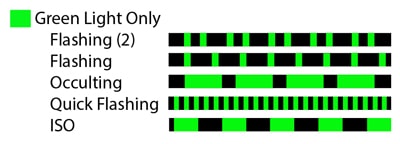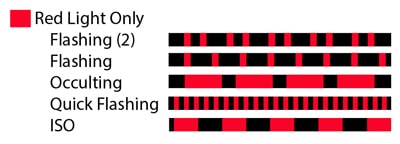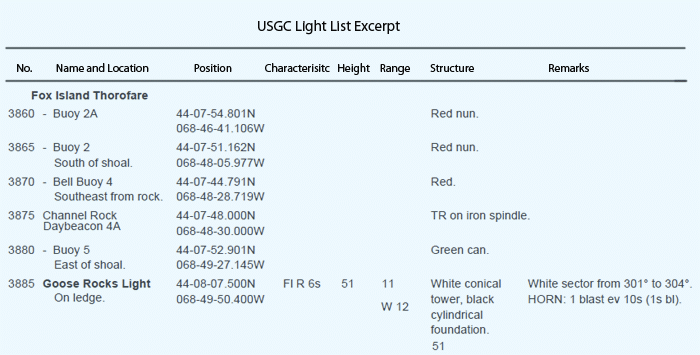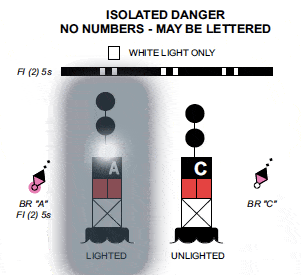
This article is an excerpt from NauticEd’s online Skipper Large Keelboats Course, a comprehensive online sailing course for beginner to intermediate sailors to learn how to sail large sailboats 26 ft (8m) and above. The Skipper Large Keelboats course is part of the Skipper Course Bundle of online courses, also teaching you how to master maneuvering under power and docking!
You can learn to sail and improve your sailing with NauticEd, the international leader in sailing education.
Lights on ATONS
Lights are installed on some ATONS. The lights are usually alternating on and off on some consistent interval to distinguish one ATON from another. The series of “ons” and “offs” are listed on the charts. This helps identify exactly which ATON you are observing. The time between each series is called a “period.”
Lighted ATONs are grouped into Flashing, Quick, Occulting, and Isophase.
- Flashing: A light in which the total duration of light in each period is clearly shorter than the total duration of darkness—and in which the flashes of light are all equal in duration.
- Example: a quick flash on then a longer period off.
- Example: the flashes might be grouped meaning that the ATON flashes quickly a number of times followed by a longer period of dark then repeating.
- Quick Light: A light turning on more than 60 (but less than 80 flashes) per minute.
- Occulting: Showing longer periods of light than darkness (opposite of flashing)
- Isophase: Showing equal periods of light and darkness—remember that «iso» means the same.
- A Long Flash: (L Fl.) A light that exhibits a long flash of 2 seconds followed by a period of longer darkness.
- Morse Code: (Mo. (letter)) A Morse-coded letter.
The colors of the lights are listed with the ATON. They are red (R), green (G), yellow (Y), and white (W). Blue is reserved for law enforcement. If there is no color listed then it is white.
Examples of the various types are shown below

Green Flashing Lights

Red Flashing Lights
There can also be a composite group flashing light. This means that more than a group of flashes make up one signal. For example, in the example below the green light flashes twice then once—then repeats after some time.
Composite Lights
You can identify the lights on the charts from the information next to the light. In the example below, the Bifurcated Lateral Maker “U” flashes composite green twice then once every 6 seconds—Fl G (2+1) 6s, while the Green Lateral Can number “9” flashes green twice every 6 seconds—Fl G (2) 6s.
Lights Shown on Charts
At night, you’ll be able to pick out the lights against the backdrop of city lights because of their alternating nature. In the example below you can see green and red lights. In a real situation, you have to concentrate on one at a time, so that the other does not distract you.
Example of Lights at Night
Caution Lights
In most countries, including the USA, the white quick flashing light is used to mark Cautionary ATONS. Regardless of the amount of lights you are viewing at one time, it is best to concentrate on one at a time to help identify. Otherwise you can become overwhelmed.
| Fl R | Fl R (2) 5s | QF | Occ Fl R | Iso Fl R | Composite Fl (2+1) 6s |
Lights at Night Can be Overwhelming
Safe Water Marks
In many countries, including the USA, the Safe Water mark is used and is a white flashing Morse code “A”. This is represented as one short followed by one long and then repeating at least 8 times per minute. Just remember A—ok.
A long 2-second flash over a 10-second period (L Fl. 10s) is specifically reserved for a safe water mark. But also, a safe water mark can be exhibited by other white lights as shown specifically on the chart.
A long 2-second flash over a 10-second period (L Fl. 10s) is also reserved for a safe water mark.
Special Purpose Marks
If a Special Purpose Buoy is lighted it displays a yellow light with fixed or slow flashing characteristics.
Isolated Danger Marks
If an Isolated Danger mark is lighted, a white light shall be used and the chart will announce the flashing sequence. The image below shows Fl (2) 5s, but this is just an example. Anytime you see a white flashing light you should be on guard. It is either safe or dangerous. Consult the chart immediately.
Sector Lights
Sector lights are sectors of color that are placed on lantern covers of certain lighthouses to indicate danger bearings. On a chart, the sector bearings are true bearings according to the chart and must be converted from magnetic bearings if using a compass. A red sector indicates a vessel is potentially in danger of running aground. Note, however, that red can be seen beyond the danger zone as well.
Sector Light
This is also seen here below in a real case of Nautical Chart #12354 Long Island Sound Eastern Port. Can you spot the Red Sector light?

Spot the Red Sector Light
Cardinal Mark Lights
Cardinal Marks if lighted use white quick flashing lights. They are easily remembered from thinking of a clock dial.
- North: Continuous quick flash
- East: 3 quick flashes (3 o’clock)
- South: 6 quick flashes followed by a long flash (6 o’clock)
- West: 9 quick flashes (9 o’clock)
Cardinal Marks at Night
Light Lists
Publications that list all the lights usually exist for each country. In the United States, the Coast Guard publishes the Light List, which can be found at
For your country or the country you are visiting, just search on “coast guard light list (country)” or “navigation light list (country).”
Below is an excerpt. Each ATON is listed by number (from the index at the back of the light list), its name, and any distinguishing location, its latitude and longitude position, its characteristic, height (if it is a lighthouse), the range that the light can be seen from, the type of structure and any remarks about the light.

Light List
Putting It All Together
The graphic below shows charted lights at a fictitious harbor entrance.

Lights on a Chart
Finally, below is an animation that repeats the above information but with real animated flashing lights so that you can get a feel for what they really look like.
Animated Lights on Navigation Marks
You can learn more in the Skipper Course....
Knowledge and theory for longer distances and overnight sailing in diverse conditions. The Skipper Course is a comprehensive online sailing course for beginner to intermediate sailors wanting to learn how to sail larger sailboats 26ft to 56ft. Or upgrade to the Skipper Course Bundle of online courses to also master maneuvering under power and docking!






